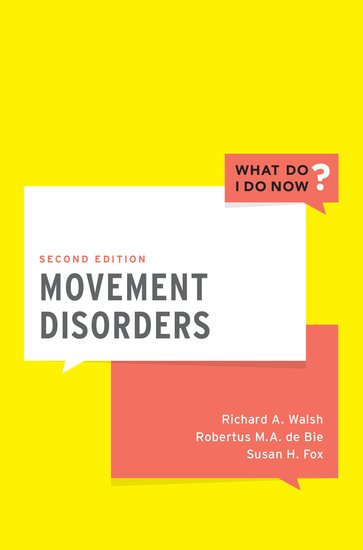At first sight, this yellow handbook brings to mind the “Gialli” (Italian for yellow) of Italian bedtime reading; these are the yellow-bound Italian crime novels. And so, Walsh and colleagues set us the task of solving several mysteries in their book, by asking: “What do you do now?”.
Thankfully, murder is not usually the answer.
In clinical story after story (31 chapters in total), we explore all types of movement disorders, from the most familiar Parkinson’s Disease to all that is unfamiliar, to a medical student at least. Each chapter begins with a brief case-history; then, having caught the reader’s attention, an explanation is provided of what we know so far about the syndrome and its pathology, using tables and brief summaries to aid memory.
All the information is up to date, and this includes news on therapeutic innovations and basic science research (genetics etc.) Throughout, an evidencebased approach is employed, with references provided, allowing for further reading if so wished.
Looking back one sees that the book contains a line of logic, so that individual cases are presented in a kind of sequence. However, the sequence does not obtrude: the writing gets you from one story to the next with very little effort, almost like a soap opera of movement disorders. The style is easy and chatty, without jarring. Medical terms are used and the scientific approach is assured despite the conversational style.
The only flaw in an otherwise excellent book is the lack of indicative titles in the summary.
By contrast, the titles are rather cryptic. While I appreciated the idea of not having the pathology revealed too early when reading through, it would be really useful to have some clear subtitles showing the name of the pathology in the index, in order to facilitate subsequent consultation.
Another observation I made about the structure of the chapters is that the final paragraph “approach to this case” is not always present. I found this paragraph extremely useful. When absent, I sometimes worried that I’d missed the boat.
Assuming that no book has the power to replace the real-life experience, I must admit that this came pretty close. The stories that introduce every chapter have the ability to attract the curiosity of the reader.
For the very interested student, a general Neurologist, a trainee in movement disorders, or a general physician, it is certainly worth reading. I would recommend this book to any professional involved in caring for patients with movement disorders, and the clear language used makes it a rewarding read for students with no prior familiarity.
So thanks to the authors, for explaining difficult concepts in simple terms, and thanks to those who decided on the colour yellow, reminding me that Medicine in general and the subject of Movement Disorders in particular is an extraordinary world, full of mysteries to be solved.

